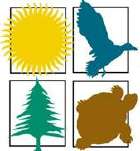Purple Loosestrife Biocontrol Project
Update:
Read about the Westborough purple loosestrife biocontrol project, a multi-year environmental and educational project undertaken by the Westborough Community Land Trust and Westborough High School students, as described in Massachusetts Wildlife magazine (No. 3 2011, pp. 4-13, “Biocontrol Comes of Age” (pdf)).
To subscribe to Massachusetts Wildlife, an inexpensive (2 years for $10), award-winning wildlife magazine, call 508-389-6300 any weekday, or visit www.mass.gov/masswildlife.
You can also read about purple loosestrife and the purple loosestrife beetles (Galerucella) used to control it in these "Nature Notes" columns:
"Invasion of the purple loosestrife" (Nature Notes of August 6, 2004)
"A good beetle comes to town" (Nature Notes of August 21, 2009)
If you would like to help with the Westborough purple loosestrife biocontrol project, please contact Annie Reid, loosestrife@westboroughlandtrust.org, 508-366-8429.
The Westborough purple loosestrife biocontrol project is a multi-year environmental and educational project to combat the non-native invasive plant purple loosestrife (Lythrum salicaria) by raising and releasing purple loosestrife beetles (Galerucella) at one or more selected sites in the summer of 2009 and four subsequent years through 2013. Purple loosestrife is taking over wetland habitats, pushing out native species and changing the ecology of our wetlands. The goal of the project is to control purple loosestrife, not to eradicate it.

The Westborough Community Land Trust (WCLT) works with State and Town groups on possible site selections and protocols for release. Sites will be determined as the project progresses, but initially Mass Department of Conservation and Recreation (DCR), Mass Fish and Wildlife, and Westborough’s Conservation Commission have given permissions or licenses for sites under their control.
WCLT has teamed up with a Westborough High School (WHS) science teacher to raise the beetles. WHS environmental science classes and the WHS environmental club are involved in this effort during the school year, and volunteers from WCLT and the wider community continue the work during the summer when school is closed.
If successful, this project will be ongoing for many years. Recommended initial releases are for three years at a site. If successful, additional sites would be selected and added to the project.
Funding: The project is funded by WCLT and 3rd party grants, including a portion of a Staples education grant, a Westborough Civic Club grant, and a Westborough Education Fund grant. WCLT is not asking the Town for funding.
Purple Loosestrife and Problems: Purple loosestrife (Lythrum salicaria) is a non-native, invasive plant that spreads rapidly and is hard to dislodge. It takes over wetlands, outcompeting native species that provide nesting material, food and shelter for wildlife. It also changes the ecology of the wetland. Purple loosestrife is well established and widespread in Westborough.
Beetle (Galerucella): The U.S. Department of Agriculture approved the use of these beetles in 1992 after 6 years of research into their safety.
The beetle is native to Europe and Asia where it is a natural “biological control” for purple loosestrife. The beetle feeds on the leaves of purple loosestrife in both its larval (caterpillar) and adult stages, and the adult beetles seek out purple loosestrife to lay their eggs on it.
The beetle does not eliminate purple loosestrife, but reduces its density by up to 90% in some studies. It has a strong affinity for purple loosestrife, preferring it to all other plants. The beetle will reproduce only on purple loosestrife. When the purple loosestrife populations are effectively reduced, beetle populations decline or move to other infestations. Some native birds and insects, including dragonflies, eat Galerucella. Beetles over-winter in the soil.
Published literature indicates that no significant long-term impacts on native plants have been observed. The beetle has been shown to eat some native plants such as swamp loosestrife (Decodon verticillatus), which is native to Massachusetts. However, this plant is not the preferred food of the beetle and it will not reproduce on this plant.
Research and Projects already in operation in Massachusetts:
The beetles are already being used in our local environment.
USDA approved use of the beetles in 1992 after 6 years of research.
State of Massachusetts has been releasing the beetles since 2000, with 43 sites now using them. http://www.mass.gov/czm/wrp/projects_pages/loosestrife.htm
U.S. Fish and Wildlife has been releasing beetles in Massachusetts since the mid-1990s. The MA Wetland Restoration Program has released beetles at over 25 sites since 2000. Mass Audubon and Mass DCR have been releasing beetles since 2006. http://www.massaudubon.org/Lessoning_Loosestrife/history.php
The Grafton Conservation Commission started a project in 2007 along the Quinsigamond River and purchased additional beetles for release in 2008. Since beetles may travel several miles to find new loosestrife populations, this project has effectively already released beetles in our local area.
The Cambridge Water Department started a project at the Fresh Pond water supply in 2007. They are concerned that invading loosestrife is affecting the ability of the ecosystem to maintain high water quality. http://www.cambridgema.gov/CWD/purpleloosestrifebiocontrol.cfm
A teacher at Uxbridge High School, Mr. David S. Worden, has worked with his students to raise and disperse beetles since 2004.
Beetles have been used for almost a decade in all the New England states.
Additional background from Mass Audubon: http://www.massaudubon.org/Lessoning_Loosestrife/ documents/A._Wetland_Functions_and_Conservation_Commissions/ 6._Conservation_Commission_Questions.doc
Westborough Community Land Trust, PO Box 838, Westborough , MA 01581
-- Contact -- Contribute or Join! --

